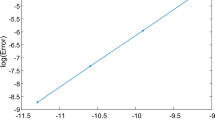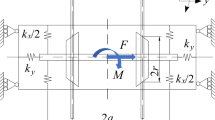Abstract
In this paper, the lateral mathematical model of a railway wheel-set with two degrees of freedom has been built. To study the effect of yaw damper on the stability of high-speed wheel-set, the constrain between the wheel-set and the bogie is assumed as rigid. In this lateral model, only the nonlinear wheel/rail contact relationship has been taken into consideration in the lateral direction, due to both the nonlinear relationship between lateral displacement and contact angle of the wheel and the rail, and the nonlinear relationship between lateral displacement and the equivalent radius of the wheel at the contact point. And the nonlinear parameters are attained by using polynomial interpolation. By using Center Manifold Theorem, the method of Normal Form and Poincaré method, the model is reduced to a planar dynamical system, and the symbolic expression of the first-order fine focus is given, which can be used to determine which kind of bifurcation will occur at the critical speed. The simulation is established by using the parameters of the wheel-set of Chinese high-speed railway vehicle CRH3, and the result is consistent with the determination of the first-order fine focus. At last, the influence of different parameters on the stability of CRH3 wheel-set is investigated.












Similar content being viewed by others
References
Ahmadian, M., Yang, S.: Hopf bifurcation and hunting behaviour in a rail wheel-set with flange contact. Nonlinear Dyn. 15, 15–30 (1998)
Carr, J.: Applications of Centre Manifold Theory. Springer, New York (1981)
Chow, S., Li, C., Wang, D.: Normal Forms and Bifurcation of Planar Vector Fields. Cambridge University Press, New York (1994)
Dong, H., Zeng, J., Xie, J., Jia, L.: Bifurcation\(\backslash \)stability forms of high-speed railway vehicles. Sci. China Technol. Sci. 56, 1685–1696 (2013)
Dukkipati, R.V., Swamy, S.N.: Lateral stability and steady state curving performance of unconventional rail trucks. Mech. Mach. Theory. 36, 577–587 (2001)
Gan, F., Dai, H., Gao, H., Wei, L.: Calculation of equivalent conicity and wheel-rail contact relationship of differen railway vehicle treads. J. Chin. Railw. Society. 35, 19–24 (2013)
Gao, X.: The “resultant bifurcation diagram” method and its application to bifurcation behaviors of a symmetric railway bogie system. Nonlinear Dyn. 70, 363–380 (2012)
Guckenheimer, J., Holmes, P.: Nonlinear Oscillations, Dynamical Systems, and Bifurcations of Vector Fields. Springer, New York (1983)
Hans, T., Engsig-Karup, A., Bigoni, D.: On the numerical and computational aspects of non-smoothnesses that occur in railway vehicle dynamics. Math. Comput. Simul. 95, 78–97 (2014)
Hans, T., Jensen, J.: Chaos and asymmetry in railway vehicle dynamics. Period. Polytech. Transp. Eng. 22, 55–68 (1994)
Haragus, M., Iooss, G.: Local Bifurcations, Center Manifolds, and Normal Forms in Infinite-Dimensional Dynamical Systems. Springer, New York (2011)
Kalker, J.J.: A fast algorithm for the simplified theory of rolling contact. Int. J. Veh. Styst. Dyn. 11, 1–13 (1982)
Knudsen, C.: Dynamics of a model of a railway wheel-set. Nonlinear Dyn. 6, 215–236 (1994)
Krauskopf, B., Osinga, H.M., Galán-Vioque, J.: Numerical Continuation Methods for Dynamical Systems. Springer, The Netherlands (2007)
Law, E.H.: Analysis of the nonlinear dynamics of a railway vehicle wheelset. Dyn. Syst. Meas. Control 95, 28–35 (1973)
Park, J., Koh, H., Kim, N.: Parametric study of lateral stability for a railway vehicle. J. Mech. Sci. Technol. 25, 1657–1666 (2011)
Parter, A.D.D.: The approximation determination of the hunting movement of a railway vehicle by aid of the method of Krylov and Bogoljubov. In: Proceedings of the l0th International Congress of Applied Mechanics, Applied Scientific Research. Vol. 10, pp. 205–228 (1960)
Polach, O.: Comparability of the non-linear and linearized stability assessment during railway vehicle design. Int. J. Veh. Styst. Dyn. 44, 129–138 (2006)
Poore, A.B.: On the theory and application of the Hopf-Friedrichs bifurcation theory. Arch. Ration Mech. Anal. 60, 371–393 (1976)
Schupp, G.: Computational bifurcation analysis: an efficient method for studying stationary and periodic motions. In: Simpack User Meeting (2004)
Schupp, G.: Bifurcation analysis of railway vehicles. Multibody Syst. Dyn. 15, 25–50 (2006)
Sedighi, H., Shirazi, K.: Bifurcation analysis in hunting dynamical behavior in a railway bogie: using novel exact equivalent functions for discontinuous nonlinearities. Sci. Iran. 19, 1493–1501 (2012)
Shabana, A.A., Zaazaa, K.E., Sugiyama, H.: Railroad Vehicle Dynamics: A Computational Approach. Taylor Francis Group, Boca Raton (2008)
Wickens, A.H.: The dynamic stability of railway vehicle wheelsets and bogies having profiled wheels. Int. J. Solids Struct. 1, 319–334 (1965)
Wickens, A.H.: Steering and stability of unsymmetric articulated railway vehicles. Dyn. Syst. Meas. Control 101, 256–262 (1979)
Zeng, J.: Numerical computations of the hunting bifurcation and limit cycles for railway vehicle system. J. Chin. Railw. Soc. 18, 13–19 (1996)
Zhang, Z., Ding, T., Huang, W., Dong, Z.: Qualitative Theory of Differential Equations. Translations of Mathematical Monographs. American Mathematical Society, Providence (1992)
Zhang, J., Yang, Y., Zeng, J.: An algorithm criterion for Hoopf bifurcation and its applications in vehicle dynamics. Acta. Mech. Sin. 32, 596–605 (2000)
Zobory, I., Nhung, T.: A mathematical investigation of the dynamics of drive-systems of railway traction vehicles under stochastic track excitation. Period. Polytech. Transp. Eng. 20, 101–107 (1992)
Author information
Authors and Affiliations
Corresponding author
Additional information
Supported by China Railway Corporation (Grant No. 2014J004-A).
Appendix
Appendix
(1) Expression of \(E_i (i=1,\ldots ,6)\) in Sect. 3.1
(2) Expression of \(F_i (i=1,\ldots ,6)\) in Sect. 3.2
(3) Parameters of CRH3 wheel-set in Sect. 4
Parameter | Comments | Value |
|---|---|---|
M | Wheel-set mass | 5279 kg |
I | Yaw moment of wheel-set | 5460 N m |
\(r_0\) | Wheel radius without lateral displacement | 460 mm |
a | Half of the rolling cycle gauge | 0.7465 m |
b | Half of the air spring arm | 0.95 m |
Parameter | Comments | Value |
|---|---|---|
\(K_{2x}\) | Secondary longitudinal stiffness | 4.383\(\mathrm{MN}\,\mathrm{m}^{-1}\) |
\(K_{2y}\) | Secondary lateral stiffness | 0.133 MN \(\mathrm{m}^{-1}\) |
\(C_{2x}\) | Yaw damper | 0.33 MN/(m/s) |
\(f_{11}\) | Longitudinal creep coefficient | 3 MN |
\(f_{22}\) | Longitudinal creep coefficient | 3 MN |
k | Coefficient relative to cosine value of wheel–rail contact angle | 1.994 |
g | Gravitational acceleration | 9.81 \(\mathrm{m/s}^{2}\) |
\(e_0\) | Coefficient relative to tangent value of wheel–rail contact angle | 22.77 |
\(e_2\) | Coefficient relative to tangent value of wheel–rail contact angle | 294502 |
\(\xi _1\) | Coefficient relative to the equivalent radius of left/right wheel | 0.20 |
\(\xi _2\) | Coefficient relative to the equivalent radius of left/right wheel | 11.77 |
\(\xi _3\) | Coefficient relative to the equivalent radius of left/right wheel | −6140.54 |
Rights and permissions
About this article
Cite this article
Zhang, T., Dai, H. Bifurcation analysis of high-speed railway wheel-set. Nonlinear Dyn 83, 1511–1528 (2016). https://doi.org/10.1007/s11071-015-2425-2
Received:
Accepted:
Published:
Issue Date:
DOI: https://doi.org/10.1007/s11071-015-2425-2




